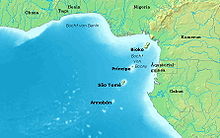History of the Jews of São Tomé
The story of the Jews of São Tomé is the story of up to two thousand Jewish children who were forcibly transported to the island of São Tomé , now the main island of the state of São Tomé and Príncipe , off the West African coast in 1493 , as well as the story of their descendants, including supposed ones and actual Jewish traditions on this island until the 17th century. Except for a short-lived Jewish community in the 19th century, there has been no Jewish history of São Tomé since then.
Origin of the children and historical background of the deportation
Most of the children brought to the island were descendants of Sephardic Jews who were driven out of their country due to the Alhambra Edict and fled to Portugal after the conquest (" Reconquista ") of the Arab Emirates of Granada in what is now southern Spain by the Spanish in 1492 . The Portuguese King John II took advantage of the plight of the displaced by letting them into the country provided they paid a tax called coima . At the same time, however, he obliged them to convert to the Christian faith within a certain period of time. Only his successor Manuel I issued a decree comparable to the Spanish Alhambra Edict in 1496, by which the Jews were obliged to leave the country by October 1497.
In 1493, however, King John II transferred the fiefdom for the island of São Tomé to a nobleman named Álvaro de Caminha , including the right to force criminals and prostitutes to the island without payment to a royal office. In this context, the proposal was made to the king to gain a threefold advantage along the way: to get rid of part of the undesirable immigrant Jewish population, to increase the following of the Christian faith and to provide the new colony of Sao Tomé with a large population that would allow the colony to survive on its own. Under the pretext that the Jews had not paid the required tax, children between the ages of two and ten were taken from the refugees. The children were forcibly baptized and given to Christian Portuguese families to teach them the Christian faith. Finally, at the end of the year, Caminho's fleet traveled to São Tomé with two thousand of these Jewish children. According to contemporary sources, six hundred of the two thousand children are said to have been alive a year later.
Alleged survival of Jewish traditions on the island of São Tomé
Many of the surviving Jewish children or their descendants achieved important, also official positions on the island and in contemporary Portugal all white São Tomés were soon considered to be Marranos or "New Christians", i.e. converted Jews who were often accused of secretly practicing the Jewish religion .
At the beginning of the 17th century, Bishop Pedro da Cunha Lobo of São Tomé - who had just arrived - complained about the "problem of Judaism" on the island, although it can be assumed that there were no more remnants of the Jewish rite among the population at that time. Nevertheless, the bishop believed he was watching a “Jewish procession” worshiping a “golden calf” directly under the window of his official residence. It was more likely that he had watched the move of one of the syncretistic cults that had developed on São Tomé through the mixture of Christian and African traditional forms of belief.
However, it can be assumed that most of the island's whites have descendants of the kidnapped Jewish children among their ancestors.
See also
literature
- Robert Garfield: A History of Sao Tome Island, 1470–1655. The key to Guinea . University Press, San Francisco 1992, ISBN 0-7734-9456-1 .
- André EA M Thomashausen: The Portuguese on São Tomé and Principe , pp. 75–91. In: Robert Ptak (ed.): Portugal's work overseas. Atlantic, Africa, Asia .; Contributions to history, geography and regional studies (Portugal series; Vol. 12). Klemmerberg-Verlag, Heidelberg 1985, ISBN 3-922265-22-7 (from published as a special edition).
- Michael Zeuske : The São Tomé-Mina-Congo-Angola Complex . In: Ders .: Slaves and slavery in the worlds of the Atlantic 1400–1940. Outlines, beginnings, actors, fields of comparison and bibliographies (slavery and post-emancipation; vol. 1). LIT Verlag, Berlin 2006, pp. 225-239, ISBN 3-8258-7840-6 .

